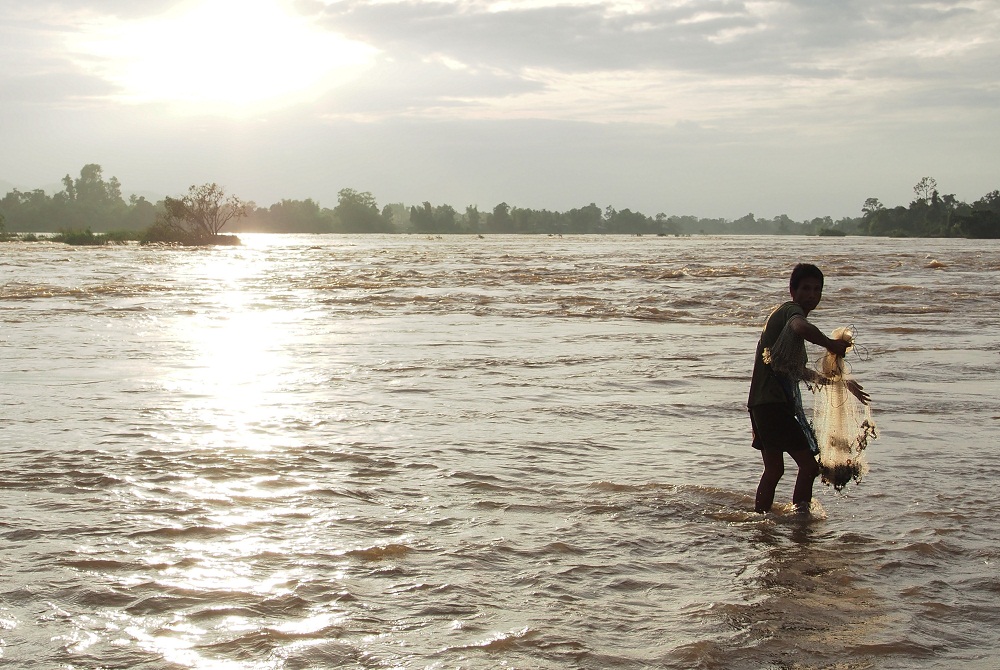Laos: Villagers barred from fishing at Don Sahong dam site
| Publisher | Radio Free Asia |
| Publication Date | 14 November 2013 |
| Cite as | Radio Free Asia, Laos: Villagers barred from fishing at Don Sahong dam site, 14 November 2013, available at: https://www.refworld.org/docid/52e0d50c23.html [accessed 31 May 2023] |
| Disclaimer | This is not a UNHCR publication. UNHCR is not responsible for, nor does it necessarily endorse, its content. Any views expressed are solely those of the author or publisher and do not necessarily reflect those of UNHCR, the United Nations or its Member States. |
2013-11-14
 A fisherman catches fish on a channel west of the Khone Phapheng falls near the future Don Sahong dam site on the Mekong River, Nov. 10, 2013. RFA
A fisherman catches fish on a channel west of the Khone Phapheng falls near the future Don Sahong dam site on the Mekong River, Nov. 10, 2013. RFA
Updated at 1:30 p.m. ET on 2013-11-16
Villagers living near the site of the planned Don Sahong dam on the Mekong River in southern Laos have been barred from fishing, a senior official said this week, after the government firmed up a schedule for construction of the controversial project.
"No Fishing" signs have been posted around the site of the planned 260-megawatt hydropower project, located some two kilometers (1.6 miles) upstream from the Cambodian border in the Siphandone area where the Mekong splits into multiple channels.
In September, Laos told a regional body overseeing development of the Mekong River that dam construction is expected to begin in November although preliminary groundwork around the dam site has gone on for months.
Deputy Minister of Energy and Mines Viraponh Viravong on Monday told reporters who were taken on a tour of the dam site that local villagers are not allowed to fish in the area, saying the volume of fish there had decreased.
"All the fish have been caught, and the number of fish is down," he said.
"It's not sustainable, and we're banning fishing."
The ban eliminates a major source of income and food security for local residents, who have been assured that those who can no longer fish for a living because of the dam will be provided with alternative jobs.
Authorities have also said that those relocated to make way for the dam will receive appropriate compensation.
Government officials had this week led reporters, foreign officials, and representatives of nongovernmental organizations on a tour of the site of the dam across the Hou Sahong channel in an apparent bid to appease opposition to the project.
'Disaster' for Mekong fish
Environment groups, including International Rivers, had warned that the project – part of Laos's plans to become the "battery" of Southeast Asia by selling electricity to its neighbors – "spells disaster" for fish migration on the Mekong and threatens regional food security.
They said the dam will block the only section of the Mekong River where fish can pass during the dry season on a large scale.
Officials and experts working on the dam have claimed that much of the criticism of the project stems from misinformation and outdated reports.
Dam developer Mega First Berhad of Malaysia has begun clearing land to build houses for workers who will be engaged for the dam construction, officials said in September.
The company has also started blasting channels adjacent to the Hou Sahong in attempts to get fish to migrate there instead, according to International Rivers.
The dam has prompted a formal complaint against Laos from downstream Cambodia to the Mekong River Commission (MRC), a four-nation body that oversees development along the key regional waterway.
Environmental groups have said Laos is avoiding MRC requirements to consult its neighbors before building the dam by claiming it is not on the Mekong mainstream.
On Sept. 30, after months of preparatory groundwork carried out at the dam site, Laos formally informed the MRC of its plans to build the dam, using the organization's "prior notification" procedures instead of the "prior consultation" process required for mainstream dams.
Laos official have said that the MRC's definitions of a "mainstream" project are vague and that they do not regard the dam across the Hou Sahong as a mainstream dam since it does not span the width of the Mekong.
Laos is also building the first dam on the mainstream Lower Mekong, the Xayaburi, which environmental groups have said poses a similar devastating threat to regional food security.
Reported by RFA's Lao Service. Written in English by Rachel Vandenbrink.
Correction: An earlier version of this story misstated the date of the deputy minister's remarks.
Link to original story on RFA website
